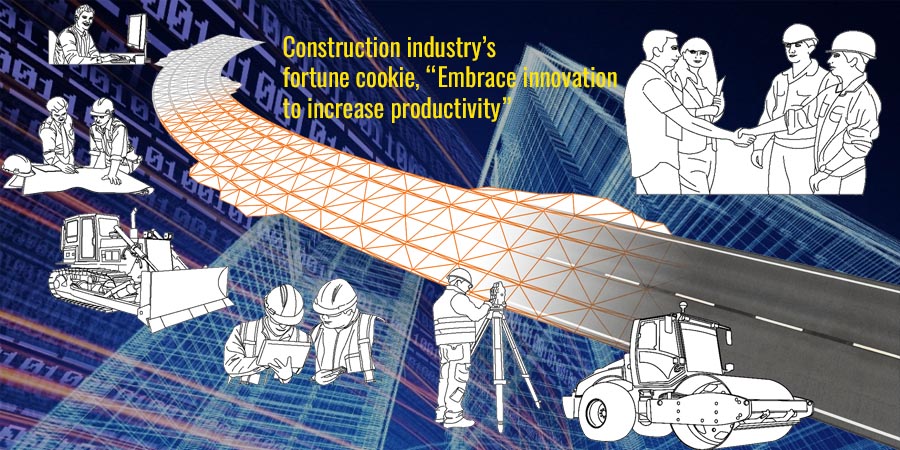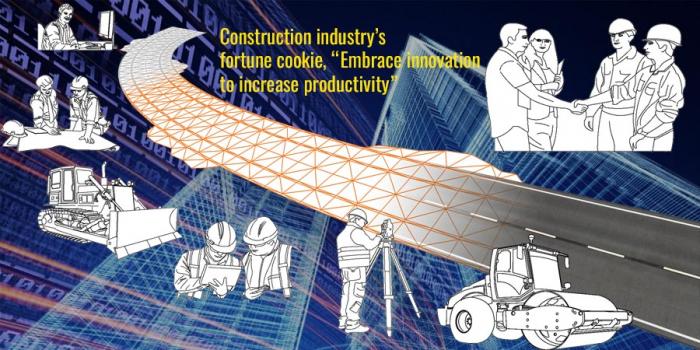

The construction industry has come a long way when in terms of embracing innovation. Leading Architectural engineering firms are running a race to build smarter cities aptly with help of BIM. Instances of using 3D printing to turn plastic bottles into sturdy structures, to designing skyscrapers hanging from asteroids – effects of innovation are clearly visible. Innovations and new technology, put together are changing physical production fundamentally, all the way from how projects are selected, funded and delivered. This is then followed by how buildings and infrastructure projects are designed, build and operated.
Collaborative procurement & integrated supply chains
However, with all this innovation and opportunities that it has to provide, construction industry still battels productivity. Firstly the labor productivity and second is productivity of the assets that are constructed. A recent survey suggests that if the workforce is 10% less efficient than expected, profits of the contractor and construction company are likely to dip by a minimum of 5%.
Reasons for poor labor productivity on construction projects include:
- Construction project isn’t planned and coordinated
- Drawings changes in location, general arrangement, assembly, component, working etc. resulting in rework
- Indecisive management failing to make timely decisions
- Poor performance of subcontractors
- Having more than required manpower on the project
- Poor supervision and lack of direction leading to under utilization of teams effectively
- Waiting for equipment or materials or having the incorrect equipment or materials
- Insufficiently skilled workers taking longer to complete tasks/ mistakes which have to be rectified due to it
- Lack of project planning to ensure much of the work is done before the onset of poor weather
The last decade was all about significant gains in productivity for several other sectors of the economy, but construction. This decade, with demand for construction output forecast to grow by 85% by 2030, scaling such poor productivity will be the sole focus for everyone in the AEC fraternity. But this is not all, as contractors also are required to consider the productivity of the assets that they construct or build in terms of:
- How many times did they succeed in delivering the outcomes for which they were hired?
- Are they, as construction firms, satisfied with the levels of revenue generated after toiling so much?
- Has their social housing development succeeded in improving the quality of life of local occupants?
- Does the new infrastructure project deliver the anticipated GDP boost to a region?
Though collaborative procurement, integrated supply chains, and progressive legislation are known to help big time – are they enough?
Technology in tomorrow’s buildings and infrastructure projects
It is the technology, which helps in making better decisions about what assets to build, and the mix and nature of those assets. One of the best examples is of increased adoption of touchscreen interfaces and mobile hardware that construction firms have leveraged, based on feedback from the crews in the field shared in real time. A few more technologies include:
- Prefabrication & Digital Fabrication
The concept of prefabrication is not new, but it is becoming increasingly convenient. The advent of technology is empowering contractors to use both, bottom up to use standardized elements for buildings and infrastructure, and top-down to split inherited design elements that can be prefabricated offsite and then assembled on-site. Prefabrication now in tune with scalability is likely to help the construction industry, attain a high degree of standardization to unlock manufacturing style productivity levels. Those days are not far when buildings will be manufactured in low-cost execution centers and shipped around the world for final assembly.
However, standardization not being suitable for every project or every component, the industry is quickly inclining towards digital fabrication, particularly 3D printing. It allows contractors to move from a 3D model of an item to a finished real-world object at a single touch without retooling, in over 80 different types of material including steel, glass, ceramic, polymer, concrete, and more.
The challenges of complexity and uniqueness of components or parts are resolved majorly with 3D printing. It sets the contractor free from constraints of standard components and allows them to focus on an ideal solution for the project with minimal waste. It is just that contractors are required to be extra cautious with the preparation of plans, elevations, section drawings including substructure section, external wall details, wall openings, eaves details, internal walls, and stair details etc. Experts at preparing detailed 2D architectural drafts from conceptual sketches can improve the productivity of architectural consultants and firms.
- Site Automation
Drones, the new technology is doing wonders by performing surveys, scanning and inspecting construction sites. Imagery taken from drones is fed into reality-software and photographs are stitched to create 3D models, essentially bringing the real world into silicon environment. A camera fitted drone for multiple applications for remote surveying of tall buildings and structures for mitigating risk and cost is no more a new thing and is being used for inspection of linear assets such as pipelines and rail corridors.
Wearable technologies can be used extensively to improve safety on construction sites. Currently, solutions such as smart vests are being developed to help construction workers to get their job done conveniently and fast, and at the same time provide the site managers with a real-time dashboard with details of how many workers are currently in areas with elevated risk and much more.
Robotics is taking construction to a new height altogether. Used to do limited repetitive tasks of handling materials and components, robots are now made capable of much more than this. They can be interconnected to sensors allowing them to capture information about the parts they are stationed at. This data then can be fed back to the control systems to make required adjustments to the robot’s operation and drive greater efficiency and higher accuracy during the process.
BIM process and design automation experts can help construction firms to speed up their architectural, structural and MEP projects. Their software and BIM experts create scripts, macros, and plugins, and use APIs to automate repetitive and time-consuming tasks. Their professionals also automate detailing, calculations, clash detection, data management, material management, and construction documentation tasks that help increase productivity.
- Data based decisions are changing construction
Informed decisions, based on accurate data, are required to be made and are likely to reshape the AEC industry. Trends in population demographics, economic growth, disposable income, and more are all the data points which are crunched by cloud computing to help contractors and construction firms conclude with:
- Which all assets to build to attain the desired outcome?
- Which projects to bid to ensure profitable growth?
- How to match project pipeline needs to an equally sized increase in funding?
Finding answers to all these questions also warrants the need of innovative software tools capable of modeling building and infrastructure information at macro scale, ultimately empowering contractors to help their clients make decisions that support a shift in the way built environments are looked at. It can initiate a shift of focus from “costs and assets”, to “outcomes and value” driven focus; a stage where contractors and their clients think alike on lines of connected systems.
Final word
The emergence of 3D printing, infinite computing, crowdsourcing, robotics, machine learning, drones, big data, the Internet of Things -IoT, predictive analytics, augmented reality, generative design, and reality capture are synonymous to disruption & are known to break and remake business models. Construction firms, architects, contractors and all involved have realized that with the kind of modernization the AEC fraternity and the entire world is experiencing; it can never be only about constructing simple buildings.


